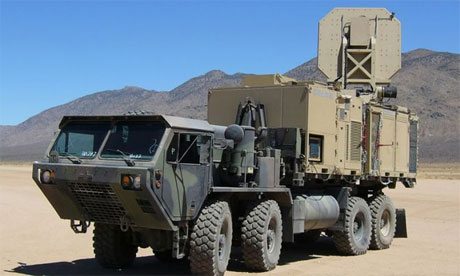A state-of-the-art millimeter-wave system developed by the Joint Non-lethal Weapons Directorate gives warfighters something more persuasive than shouting but less harmful than shooting when dealing with potentially hostile crowds, Defense Department experts said during a recent demonstration.
At a training area on Marine Corps Base Quantico in northern Virginia, members of the media gathered March 9 to watch two prototype active-denial systems — one built onto a heavy expanded-mobility tactical truck, the other onto a Humvee — deliver a man-sized heat beam to officials and experts, then to service members pretending to be angry protestors, then to fearless volunteers.
The beam, from the same millimeter-wave technology used in airport body scanners, penetrates only 1/64th of an inch into a person’s skin and cornea, heating water molecules in the tissue and generating an instinctive and irresistible urge to run from the effect.
“For our forces out there operating in uncertain situations, what it gives them is decision time — time to decide if there’s a real threat without using lethal means,” said Marine Corps Col. Tracy Tafolla, director of the Joint Non-lethal Weapons Directorate.
“You’re not going to hear it, you’re not going to smell it, you’re going to feel it, and that provides us with some advantages we can use,” he said.
Stephanie Miller, chief of the radio frequency bioeffects branch for the Air Force Research Laboratory, said the frequency used in the active denial system is 95 gigahertz.
“Our lab has studied … how much energy it takes to produce the repel response of running away from the beam, how much energy to produce a blink response, which protects the eye, and then on the flip side of that, how much energy would it take to produce some form of injury, whether that’s eye irritation or a skin blister,” she said. “We understand what the safety margins are, and in fact, these systems have been designed so that you can’t put enough energy on the surface of the eye in the time it takes a person to blink to cause damage to the eye.”
Miller’s group also worked with scientists at the M.D. Anderson Cancer Center to make sure the beam doesn’t initiate skin cancer or make an existing cancer worse. And effects from the beam are temporary, she said.
“If you open a hot oven and you get a blast of heat, your skin may feel a little tingly, a little tender,” Miller said, explaining that’s how the beam makes people feel for 10 to 15 minutes.
The technology may be state-of-the-art, but it’s not new. Tafolla said that it’s nearly 18 years old, and Diana Loree, assistant chief scientist for the Air Force Research Laboratory’s directed-energy directorate at Kirtland Air Force Base, N.M., explained how it works.
Each truck carries all the electrical generators and thermal systems the transmitters need, operator station included, independent of any grid, Loree said, calling it “a very simple piece of equipment.”
From the equipment built onto the truck, a high-powered vacuum called a gyrotron turns electricity into radio frequency waves and heat, and water systems in the equipment absorb this excess heat.
“So the electromagnetic wave is created by that gyrotron and then is fed through a series of mirrors that illuminate a reflector antenna — it’s bouncing there and getting shape and then bouncing off a main aperture and coming downrange,” Loree said.
The beam goes in the direction that the operator is pointing, she said, adding that the operators have a simple set of controls. “They have several day/night cameras that look through the middle of the invisible beam so they know what they’re targeting,” she said, “and there’s a simple touch-screen operation.”
The transmitter, Loree said, is 100 times the power of a standard microwave oven. “I can’t pop a bag of popcorn with that 100-times-the-power transmitter, because the radio frequency is not penetrating deep enough to internally heat the material.”
Susan LeVine, principal deputy for policy and strategy in the Joint Non-lethal Weapons Directorate, said the nonlethal weapons program is a joint operation.
“Our office is headed by a Marine Corps colonel, but he is in a joint billet and within our office we have all the services represented,” she said. “As part of being the executive agent for nonlethal weapons, we have a research and development budget and we use that funding to sponsor research all across the Defense Department, across all the services. One of the programs that we’ve been funding is the active denial system, which has been led by the Air Force Research Laboratory.”
Military utility assessments have been conducted at Creech Air Force Base, Nev., for entry control point scenarios; Fort Benning, Ga., for more urban scenarios; and Eglin Air Force Base, Fla., firing from the beach on personnel on a Coast Guard vessel to show maritime applications.
The objective of joint concept technology demonstrations, which developed the active denial prototypes, “is to rapidly take promising technology and assemble it in a configuration” so that it can be used and evaluated, she said.
The “trigger point” for the technology to be used, LeVine said, involves service requirements and a service decision to further develop it and field it.
“We’re continuing to make the technology available to the services if they want to experiment and try it out,” she said.










